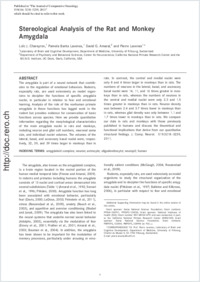Stereological analysis of the rat and monkey amygdala
- Chareyron, Loïc J. Laboratory of Brain and Cognitive Development, Department of Medicine, University of Fribourg, Switzerland
- Banta Lavenex, Pamela A. Laboratory of Brain and Cognitive Development, Department of Medicine, University of Fribourg, Switzerland
- Amaral, David G. Department of Psychiatry and Behavioral Sciences, Center for Neuroscience, California National Primate Research Center and the M.I.N.D. Institute, UC Davis, USA
- Lavenex, Pierre Laboratory of Brain and Cognitive Development, Department of Medicine, University of Fribourg, Switzerland
-
14.09.2011
Published in:
- The Journal of Comparative Neurology. - 2011, vol. 519, no. 16, p. 3218–3239
English
The amygdala is part of a neural network that contributes to the regulation of emotional behaviors. Rodents, especially rats, are used extensively as model organisms to decipher the functions of specific amygdala nuclei, in particular in relation to fear and emotional learning. Analysis of the role of the nonhuman primate amygdala in these functions has lagged work in the rodent but provides evidence for conservation of basic functions across species. Here we provide quantitative information regarding the morphological characteristics of the main amygdala nuclei in rats and monkeys, including neuron and glial cell numbers, neuronal soma size, and individual nuclei volumes. The volumes of the lateral, basal, and accessory basal nuclei were, respectively, 32, 39, and 39 times larger in monkeys than in rats. In contrast, the central and medial nuclei were only 8 and 4 times larger in monkeys than in rats. The numbers of neurons in the lateral, basal, and accessory basal nuclei were 14, 11, and 16 times greater in monkeys than in rats, whereas the numbers of neurons in the central and medial nuclei were only 2.3 and 1.5 times greater in monkeys than in rats. Neuron density was between 2.4 and 3.7 times lower in monkeys than in rats, whereas glial density was only between 1.1 and 1.7 times lower in monkeys than in rats. We compare our data in rats and monkeys with those previously published in humans and discuss the theoretical and functional implications that derive from our quantitative structural findings.
- Faculty
- Faculté des sciences et de médecine
- Department
- Département de Médecine
- Language
-
- English
- Classification
- Biological sciences
- License
-
License undefined
- Identifiers
-
- RERO DOC 28170
- DOI 10.1002/cne.22677
- Persistent URL
- https://folia.unifr.ch/unifr/documents/302215
Other files
Statistics
Document views: 155
File downloads:
- pdf: 265
- Supplementary material: 146

